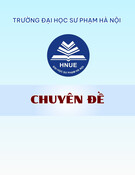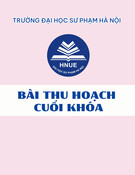
TẠP CHÍ KHOA HỌC QUẢN LÝ GIÁO DỤC SỐ 01(45), THÁNG 3 – 2025
41
CÁC YẾU TỐ ẢNH HƯỞNG ĐẾN ĐỊNH HƯỚNG
GIÁ TRỊ LỐI SỐNG CỦA SINH VIÊN: NGHIÊN CỨU TRƯỜNG HỢP
TẠI TRƯỜNG ĐẠI HỌC SƯ PHẠM THÀNH PHỐ HỒ CHÍ MINH
FACTORS INFLUENCING STUDENTS’ LIFESTYLE VALUE ORIENTATION:
A CASE STUDY AT HO CHI MINH CITY UNIVERSITY OF EDUCATION
ĐOÀN MAI NGUYÊN, NGUYỄN NGỌC HUỲNH TRÂM, PHẠM THIÊN KIM, ĐẶNG TRẦN
NHẬT HOAN, DƯ THỐNG NHẤT, nhatdt@hcmue.edu.vn
Trường Đại học Sư phạm Thành phố Hồ Chí Minh.
THÔNG TIN
TÓM TẮT
Ngày nhận: 24/02/2025
Ngày nhận lại: 16/03/2025
Duyệt đăng: 18/03/2025
Mã số: TCKH-S01T03-2025-B05
ISSN: 2354 - 0788
Định hướng giá trị lối sống của sinh viên đóng vai trò quan trọng
trong giáo dục và phát triển con người, định hình sự trưởng thành
cá nhân cũng như những đóng góp của họ cho xã hội. Hiểu rõ các
yếu tố ảnh hưởng đến giá trị lối sống của sinh viên là điều cần thiết
để các trường đại học nâng cao chất lượng giáo dục và thúc đẩy sự
phát triển toàn diện của sinh viên. Nghiên cứu sử dụng phương pháp
khảo sát, dữ liệu được thu thập từ mẫu thuận tiện gồm 389 sinh viên
Trường Đại học Sư phạm Thành phố Hồ Chí Minh. Phân tích mô tả
và tương quan cùng với phân tích nhân tố khẳng định được áp dụng
để kiểm tra mối quan hệ giữa các biến số và kiểm nghiệm mô hình
đề xuất. Kết quả nghiên cứu cho thấy có năm yếu tố chính ảnh hưởng
đến giá trị lối sống của sinh viên: giáo dục gia đình, giáo dục nhà
trường, quan hệ bạn bè, truyền thông và định hướng cá nhân. Các
chỉ số thống kê như tải số nhân tố, giá trị riêng và phương sai giải
thích đã xác nhận độ tin cậy của mô hình năm nhân tố. Những phát
hiện này cung cấp hàm ý quan trọng cho các nhà nghiên cứu giáo
dục, quản lý giáo dục và nhà hoạch định chính sách. Chúng góp
phần hỗ trợ xây dựng chương trình giảng dạy và chiến lược tổ chức
giáo dục nhằm thúc đẩy những giá trị lối sống tích cực trong sinh viên.
Từ khóa:
giá trị lối sống, định hướng giá trị,
yếu tố ảnh hưởng, sinh viên
Keywords:
lifestyle value, value orientation,
influencing factor, student.
ABSTRACT
The lifestyle value orientation of students plays a critical role in
education and human development, shaping their personal growth
and societal contributions. Understanding the factors that influence
students’ lifestyle values is essential for universities to enhance
educational quality and foster holistic student development. The study
employs a survey method, with data collected from a convenient
sample of 389 students at Ho Chi Minh City University of Education.
Descriptive and correlation analyses, along with Confirmatory Factor
Analysis (CFA), were employed to examine the relationships among
variables and validate the proposed model. The findings indicate that
five primary factors influence students’ lifestyle values: family
education, school education, peer relationships, media exposure, and
self-orientation. Statistical measures such as factor loadings,
eigenvalues, and explained variance confirmed the reliability of the
five-factor model. These insights provide valuable implications for
educational researchers, academic administrators, and policymakers,
supporting the development of curricula and institutional strategies
that promote positive lifestyle values among students.






























